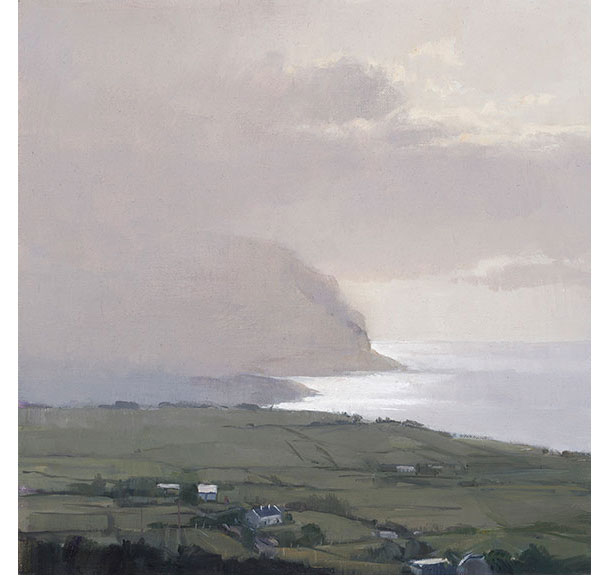
Glinsk, Oil on canvas, 12 x 12 inches (Courtesy of the Gross McCleaf Gallery)
I would like to thank Jeffrey for taking the time to share his thoughts and work in this email interview. Jeffrey Reed lives in Pennsylvania where he paints and teaches as well as spending summers on the Western coast of Ireland at the Ballinglen Arts Foundation. There is currently a showing of 31 of his recent landscapes at the Gross McCleaf Gallery in Philadelphia where Jeffrey Reed has shown for many years. This show is hanging until September 28th.
Reed received his BFA from the Maryland Institute College of Art and his MFA from the University of Pennsylvania. He is currently an Associate Professor of Art at the Community College of Philadelphia.

Easky, Oil on canvas, 14 x 14 inches
Larry Groff: Can you tell us something about your background? What were your early years like as a painter and how did you become a landscape painter? Who have been important influences for you?
Jeffrey Reed: I grew up outside of Annapolis Maryland on the Magothy River, a tributary of the Chesapeake Bay. All of my interests seemed to be centered around the outdoors, either on or near the water. It is where I looked for the pulse of the day and felt most alive and connected to the world. I developed an interest in drawing and painting at an early age and it seemed natural to paint the landscape as a subject.
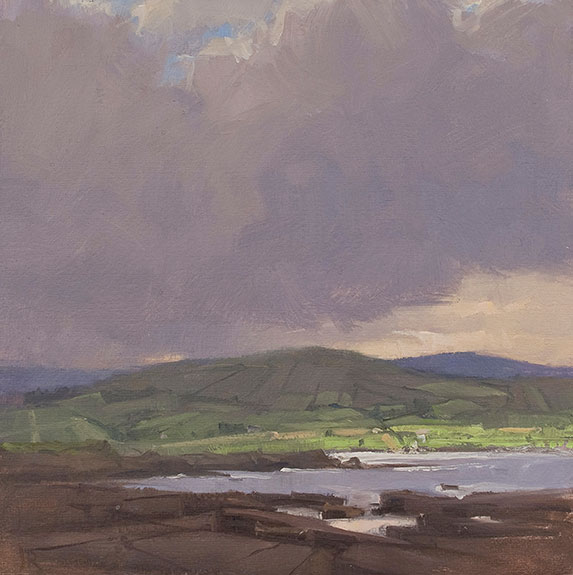
Towards Ballyglass, Oil on canvas, 8 x 8 inches
After one year at a small liberal arts school I transferred to the Maryland Institute College of Art. I feel very fortunate to have landed there. I say landed because I had no sense of what the life of an artist might be. I had no role models. At MICA my world opened up and my teachers became my biggest influences. Barry Nemett, Mark Karnes, Phil Koch and Raoul Middleman were the teachers I studied with the most, but there were others. As students we were exposed to many styles of painting, both historical and contemporary, as we learned the language of art. I found support for my interest in landscape painting in the classes of Phil Koch and Raoul Middleman. The president of MICA at that time was Bud Leake, a wonderful landscape painter and very inspiring.
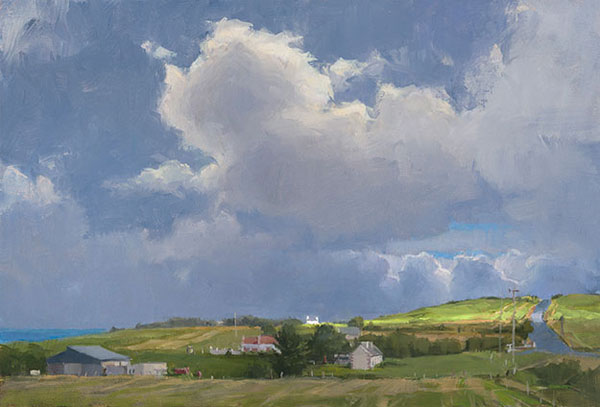
Low Sky, Oil on canvas, 12 x 18 inches
The first painter that I became infatuated with was Charles Francois Daubigny. One of his paintings, The Coming Storm; Early Spring, is at the Walters Art Gallery in Baltimore and I would stop by and look at it what seemed to be every week. As I stood in front of it, I could feel the wind and sense the light. It seemed magical. Edouard Vuillard, John Frederick Kensett and Tom Thomson are a few other painters that I identified with as a younger artist. There was something about their quiet connection to the world around them that appealed to me.
LG: What are your most important considerations when deciding if a scene interests you enough to paint? What do you look for in a selection?
JR: Interesting forms would be the short answer. Do I want to explore a particular form and does it have a enough visual interest are the first questions I ask. Once I find a potential subject I’ll then ask the more formal questions about contrast, space, light, atmosphere and design. How will it become a painting?
I have been to the Ballinglen Arts Foundation in County Mayo, Ireland many times. The first month that I was there I was overwhelmed by the beauty and power of nature and painted postcards. I eventually realized that I was painting scenes and not paintings. I was looking but the paintings were not driven by formal decisions and the result was that I had a stack of beautiful scenes but not very good paintings.
I like Fairfield Porter’s response about what a critic looks for in a representational painting versus an abstract painting, and I paraphrase, “In representational painting one must look for the abstract and in abstract painting one must look for the subject”.
I am more interested in the evocative qualities in the landscape than the narrative. I look for the uniqueness of the light and atmosphere on a given day

Lancaster Evening Sky, Oil on canvas, 10 x 11 inches
LG: Is capturing the first impression of the scene and the reasons you wanted to paint it something you try to hold on to throughout the painting or do you tend to leave the composition more open, allowing it evolve with the changing light, mood, etc?
JR: That is my intention. However I never know what challenges might present themselves. The painting can reveal unforeseen problems as it progresses and nature might reveal something that I want to be receptive too. I like that the light and weather are constantly changing, it gives me choices.
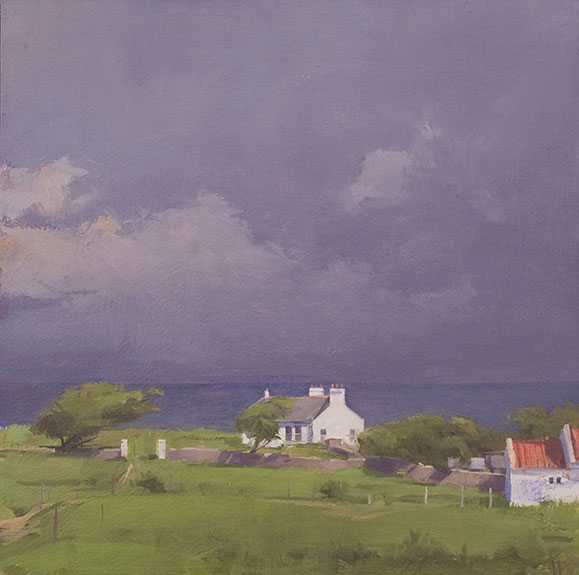
John’s Early House, Oil on canvas, 10 x 10 inches
LG: I understand you sometimes will work more on the painting in studio away from the motif. Any rules you give yourself here such as a time-limit or no photos? What you tend to focus on when you bring your wet painting in the studio for further development? Do you ever change things significantly from what you saw on site?
JR:: Fifteen years ago I spent almost an entire year working in the studio from small studies, drawings and photographs. The paintings were terrible. I learned that for what was important to me, light and atmosphere, I couldn’t make up and a camera couldn’t capture. I also realized that the experience of being in the landscape was a large part of the painting process for me.
I returned to the landscape with a new intensity and focus. If I establish the light in a painting on location I can bring it back to the studio and work on it. In the studio I tend to work on the design and drawing elements and not the color and light. A very important aspect of working in the studio for me is that it allows me to separate from the subject and look at the painting on it’s own merits. There is a distillation that takes place that I find helpful. Historically painters like Church and Corot would do studies of their studies for much the same reason. At this point I still do the vast majority of my painting on location.
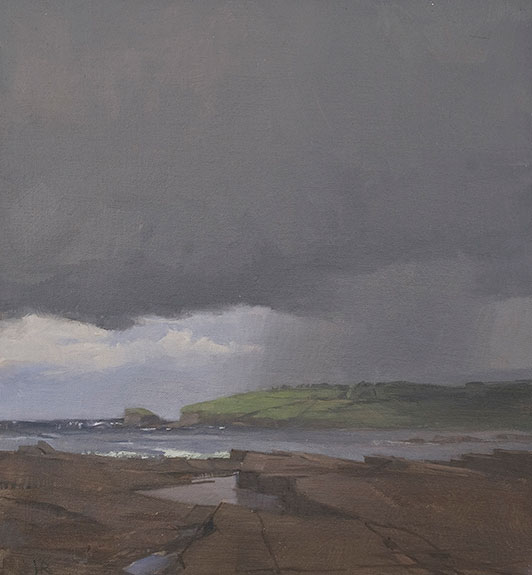
Belderg Incoming Rain, Oil on canvas, 12 x 11 inches
LG: You often choose situations where the light and sky must be changing quickly and constantly. With so much of the subject matter in flux does it ever start to be less about observation and more about memory and invention? Does the challenges and difficulties in aiming for a moving target add to the excitement?
JR: I do like being outside when the light and weather are changing. I have lost some paintings certainly, but I have also saved some paintings because I was presented with new options. It is not unusual for me to change a sky several times during the course of a painting, if what I paint at first doesn’t work with the composition.
A change in the weather or just turning around to see the sky behind me might offer better compositional choices. However, the painting has to be consistent and believable. Ultimately paintings have to stand on their own merits, not just be a record of what was seen. Having a clear objective in a painting is also very helpful. It’s nice when what I’m looking at and what the painting needs are the same, but it is rare. There is always some invention.
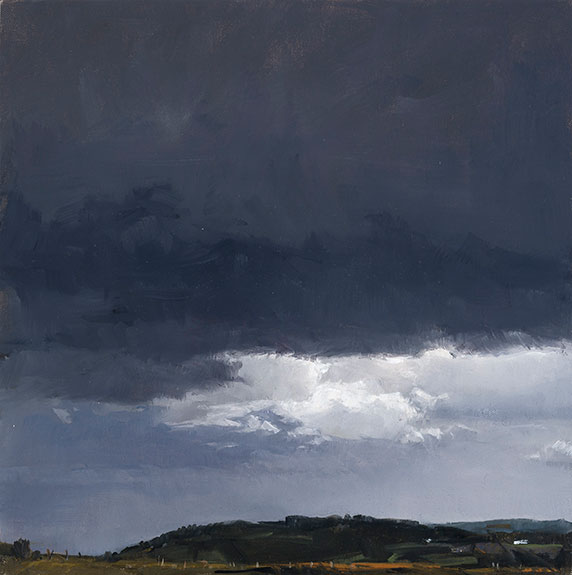
Heavy Sky, Oil on canvas, 12 x 12 inches
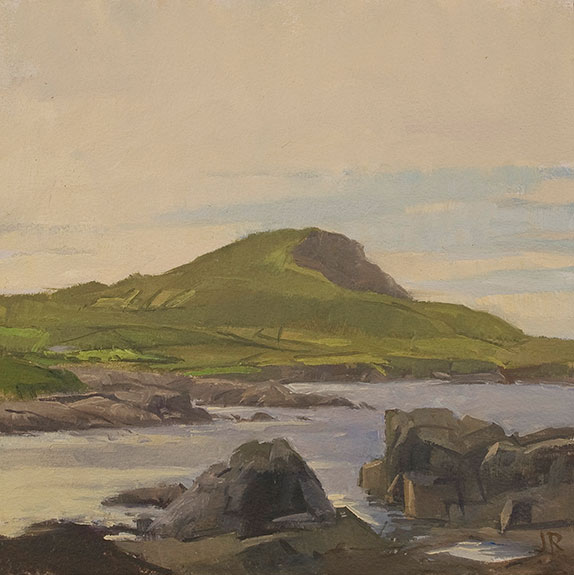
Glinsk I, Oil on canvas, 8 x 8 inches
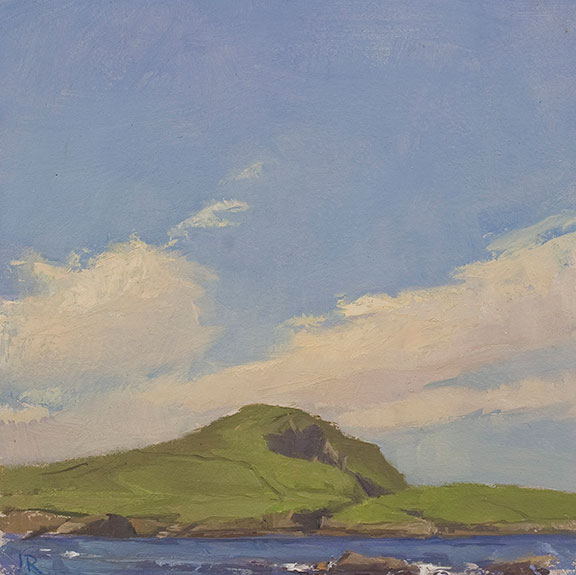
Glinsk II, Oil on canvas, 8 x 8 inches
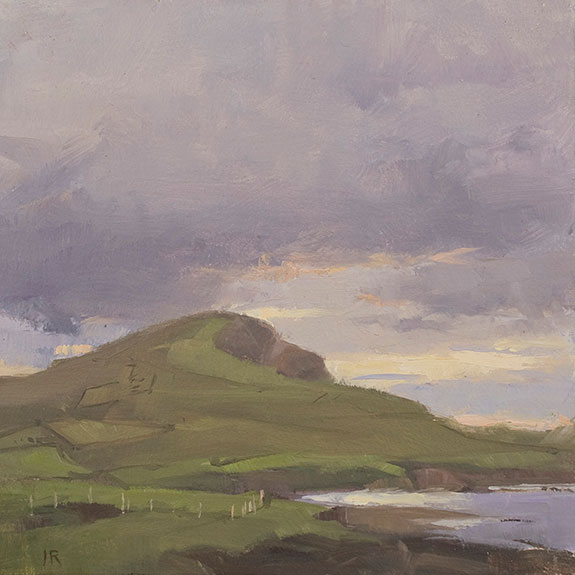
Glinsk III, Oil on canvas, 8 x 8 inches
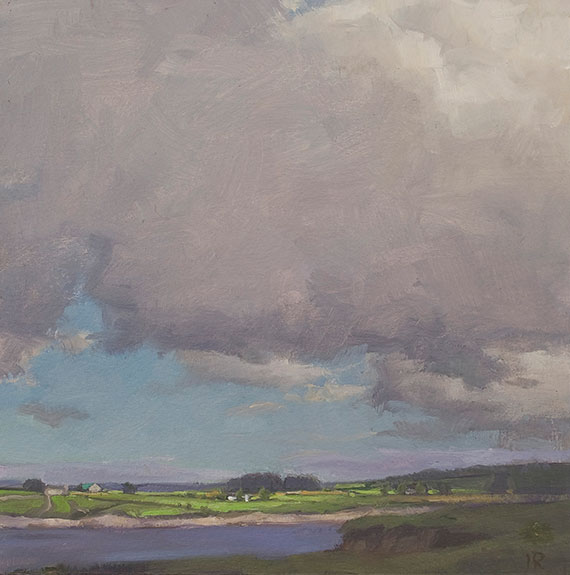
Portnhalla, Oil on canvas, 8 x 8 inches
LG: Many of your recent paintings tend to be small, in a 8 – 12 inch range. I’ve read the brushes you use for these works tend to be quite large. Please tell us something about why you prefer to make smaller paintings?
JR: Making smaller paintings is a result of traveling and being practical. That said, the paintings need to get bigger, even the travel paintings. I have become interested in spending more time on each painting as a result of looking more closely at the subject and pursuing a wider range of marks and details. I am now working on larger surfaces up to 24 inches and some long horizontal formats.
In terms of brushes, I use a one-inch flat brush for most of my work. I place a lot of importance on shape relationships to establish a composition and light. I feel that a strong foundation is needed for the detail to exist. I share the philosophy of Charles Hawthorne about wielding a large brush.

Ballyglass Fog, Oil on canvas, 12 x 12 inches
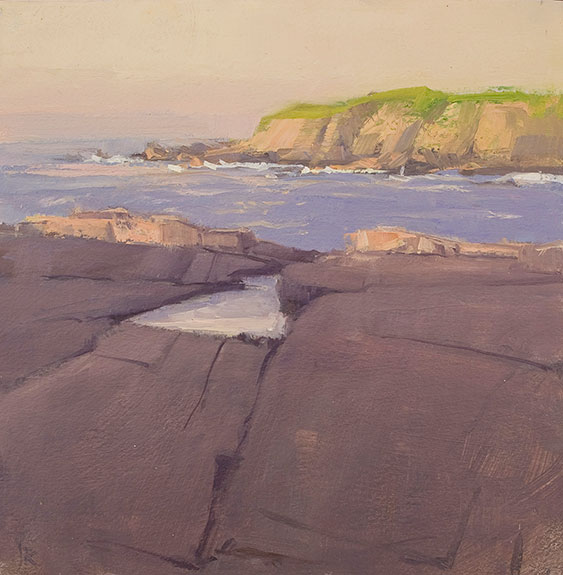
Belderg Evening, Oil on canvas, 8 x 8 inches
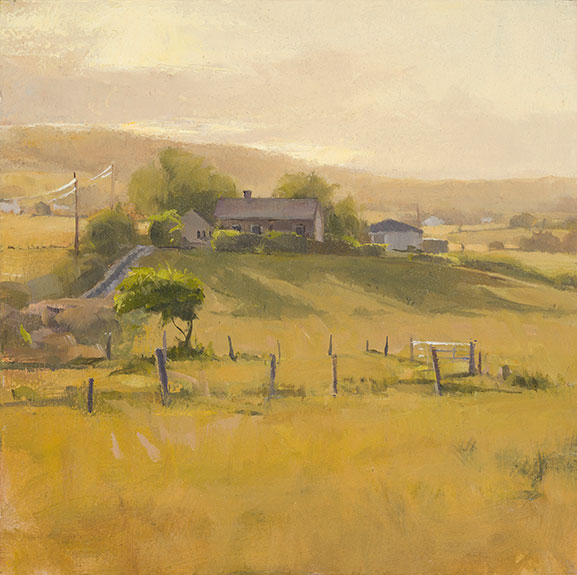
Yellow Evening, Oil on canvas, 8 x 8 inches
LG: What can you tell us about your process, anything noteworthy about your approach to painting outside? What paints do you put out on your palette?
JR: My painting process is fairly straightforward; I like to keep it simple. I work on a warm gray ground that allows me to work towards the light or dark ends of the gray scale. Most of the paintings are built around a key relationship of color and/or light. A good example might be where the sky meets the horizon. Establishing this relationship helps guide me through the other decisions in the painting.
In my paint box I carry a warm and cool of each of the primary colors, one tube of each secondary color and a couple of earth colors along with black and white. I rarely if ever use all of the colors that I carry in a single painting. I use a lot of limited palettes based on my objectives. I want the light in each painting to be specific in quality and I find that bracketing my palette can help me achieve this. It also forces me to pay more attention to color relationships.
As an example of a limited palette, recently I used black, white, violet, a cool yellow and raw sienna for a painting that had a strong yellow light bathing the composition. Yellow Evening (above) is an example of a painting where such a palette was used.
LG: I understand you’ve taught painting for many years. Do you teach landscape painting or is primarily studio based training? Is landscape painting something that is taught in the universities or it something people need to figure out more on their own?
JR: I have been teaching at the Community College of Philadelphia for over 25 years. We have a transfer program and I teach essentially foundation level classes. Drawing is the core of our program; it is perceptually based and rigorous. I teach basic drawing, figure drawing as well as basic painting. In the second semester of painting we do introduce the landscape.

Cut Field, Ballycastle, Oil on panel, 9.5 x 9.5 inches
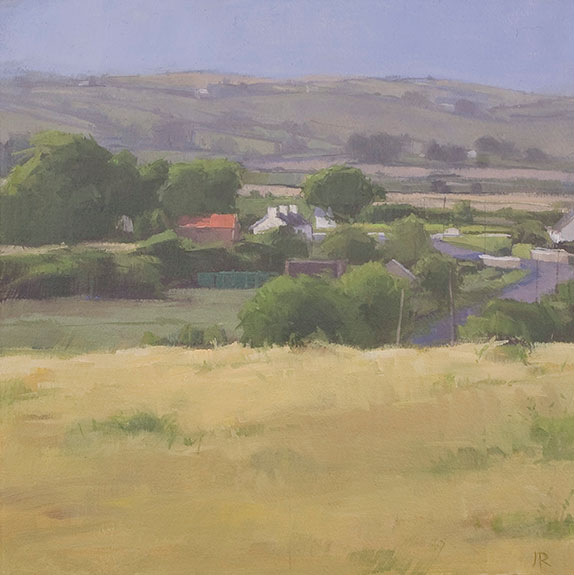
Yellow Field, Oil on canvas, 9.5 x 9.5 inches
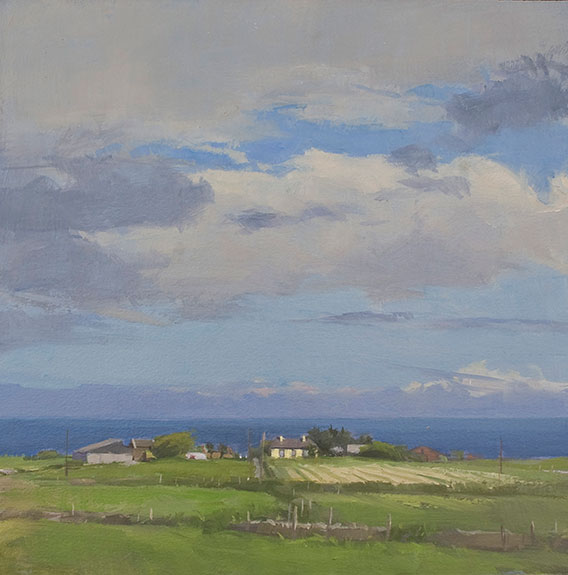
Yellow House, Oil on canvas, 10 x 10 inches
LG: We live in a time with a very high painter to average joe ratio. More painters than ever are making very exciting and original work, especially painters seen on this blog. At the same time, the art world seems to hold a perennial vigil around Painting’s death bed with everyone fighting over who deserves the biggest cut from the will. Care to comment on what’s up with that?
JR: I never ask if painting or studying the landscape is relevant. As long as we have a landscape and people want to connect with their environment there will be landscape based art. If we want to know who we are as a people we can’t ignore painting, it is a part of our history and tradition. As an art educator, I believe strongly that it is through the study of painting, sculpture and drawing where students learn the visual language.
There are many choices for artists today in terms of media and materials, painting is one of the choices but it is neither obsolete nor irrelevant. I agree with you Larry that there are many very good painters today, perhaps we are just having to share the spotlight.

Cork II, Oil on canvas, 8 x 8 inches
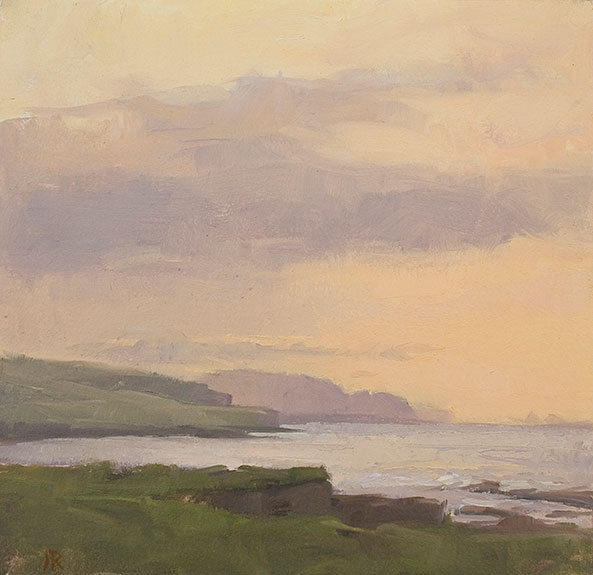
June Evening, Oil on canvas, 8 x 8 inches
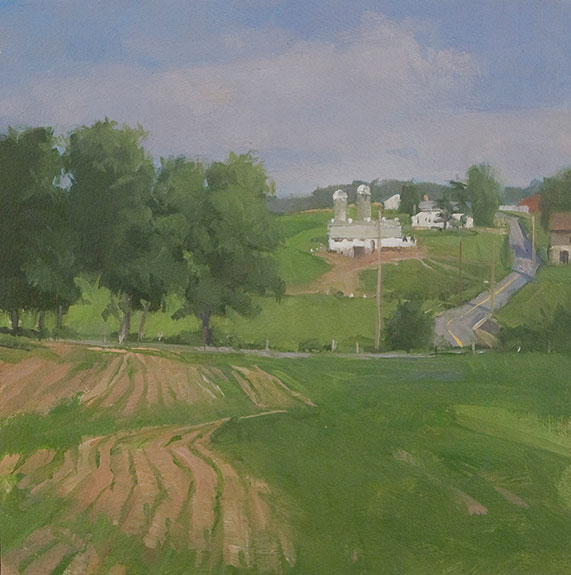
Jacob’s Farm, Oil on canvas, 8 x 8 inches





I found very nice the paintings….the light the skies the choose of the landscapes and the atmosphere ….nice work
Excellent interview and beautiful paintings.
Dear Mr. Reed,
If ever I win the lottery you will be able to count on me for a portion of your income. Until that time comes please know how thankful I am to see your work, even if only online, because it gives hope to painters who choose a more traditional path in our current art environment.
Thank you also Larry for continuing your interviews. I only wish I had the resources to support your work as well…
Sincerely,
Noel
I love them especially the “Yellow Evening” Thats it I’m going on another road trip this time to paint the countryside! Thanks for the “inspiration.”
As repeat visitors to our favorite place on earth, Ballycastle, it was with great pleasure we discover Jeffrey Reed and his work!!
My best friend’s aunt was one of the founders of the Ballingen Foundation (a fact discovered only after our 2nd visit) and I hope to find Mr Reed teaching there soon, in which case I will have the perfect reason to stay in Ballycastle the entire summer!!
Beautful work, and great interview!
Chris O’Keefe
These all have an effortless-ness and clarity to them which I find amazing. You can tell that Jeffrey’s in total control; I’ve seen his work at Gross McCleaf a few times and admire them very much. He ‘gets’ the air and atmosphere…no small feat. Also, I find the square format intriguing…something that I always shy away from. He makes it work…great painting!
You can almost feel the weather, the sunlight when you view these…the sense of the moment remains.
Beautiful landscapes!
Mr reed is unpretentious and earnest and it was a pleasure reading this interview.
thank you!
These paintings blow me away. I love the sky/land proportions . . . . where it is mostly sky. Really, I could hardly breathe looking at these paintings. Thank you so much, Jeffrey Reed.
Inspiring! Just a question- “Easky”- Are the colors really like that, or is the overall purplish cast a result of the camera?
I absolutely love these landscape paintings. One question – Why the constant use of the square for the picture plain? I love it, by the way, but I’m curious.
Wonderful interview… excellent questions, comprehensive and candid statements. Thank you for the terrific information, stunning images, and inspirational energy. In particular, this quote hits home, especially in today’s “art-industry” climate : “I never ask if painting or studying the landscape is relevant. As long as we have a landscape and people want to connect with their environment there will be landscape based art. If we want to know who we are as a people we can’t ignore painting, it is a part of our history and tradition.”
An insight into the work of this most accomplished painter. I also paint plein air and come across many of the same problems when trying to capture a moment, with the weather in flux. Here in west Wales we have similar landscapes and a weather pattern that is constantly changing. The smaller format is one that is practical in these outdoor situations and the use of a large brush is something that I also find helps to prevent becoming too bogged down with unnecessary detail.
I love this work, it speaks for itself.